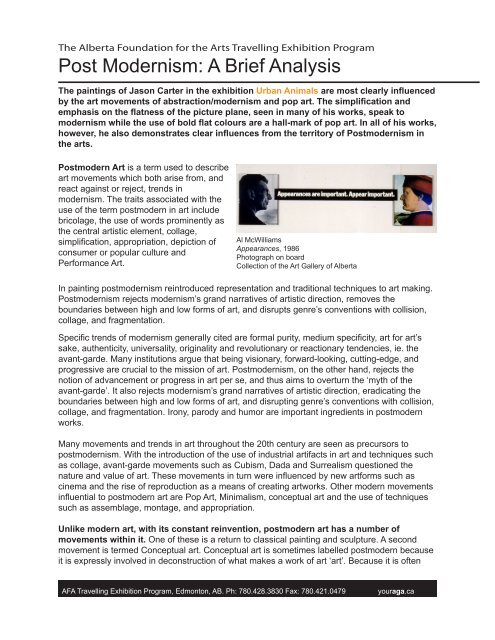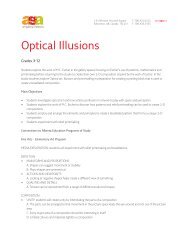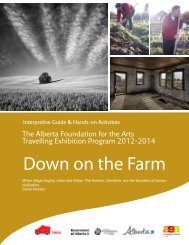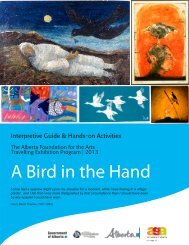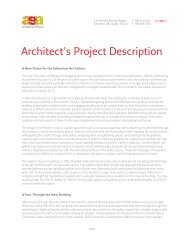Urban Animals - Art Gallery of Alberta
Urban Animals - Art Gallery of Alberta
Urban Animals - Art Gallery of Alberta
Create successful ePaper yourself
Turn your PDF publications into a flip-book with our unique Google optimized e-Paper software.
The <strong>Alberta</strong> Foundation for the <strong>Art</strong>s Travelling Exhibition Program<br />
Post Modernism: A Brief Analysis<br />
The paintings <strong>of</strong> Jason Carter in the exhibition <strong>Urban</strong> <strong>Animals</strong> are most clearly influenced<br />
by the art movements <strong>of</strong> abstraction/modernism and pop art. The simplification and<br />
emphasis on the flatness <strong>of</strong> the picture plane, seen in many <strong>of</strong> his works, speak to<br />
modernism while the use <strong>of</strong> bold flat colours are a hall-mark <strong>of</strong> pop art. In all <strong>of</strong> his works,<br />
however, he also demonstrates clear influences from the territory <strong>of</strong> Postmodernism in<br />
the arts.<br />
Postmodern <strong>Art</strong> is a term used to describe<br />
art movements which both arise from, and<br />
react against or reject, trends in<br />
modernism. The traits associated with the<br />
use <strong>of</strong> the term postmodern in art include<br />
bricolage, the use <strong>of</strong> words prominently as<br />
the central artistic element, collage,<br />
simplification, appropriation, depiction <strong>of</strong><br />
consumer or popular culture and<br />
Performance <strong>Art</strong>.<br />
Al McWilliams<br />
Appearances, 1986<br />
Photograph on board<br />
Collection <strong>of</strong> the <strong>Art</strong> <strong>Gallery</strong> <strong>of</strong> <strong>Alberta</strong><br />
In painting postmodernism reintroduced representation and traditional techniques to art making.<br />
Postmodernism rejects modernism’s grand narratives <strong>of</strong> artistic direction, removes the<br />
boundaries between high and low forms <strong>of</strong> art, and disrupts genre’s conventions with collision,<br />
collage, and fragmentation.<br />
Specific trends <strong>of</strong> modernism generally cited are formal purity, medium specificity, art for art’s<br />
sake, authenticity, universality, originality and revolutionary or reactionary tendencies, ie. the<br />
avant-garde. Many institutions argue that being visionary, forward-looking, cutting-edge, and<br />
progressive are crucial to the mission <strong>of</strong> art. Postmodernism, on the other hand, rejects the<br />
notion <strong>of</strong> advancement or progress in art per se, and thus aims to overturn the ‘myth <strong>of</strong> the<br />
avant-garde’. It also rejects modernism’s grand narratives <strong>of</strong> artistic direction, eradicating the<br />
boundaries between high and low forms <strong>of</strong> art, and disrupting genre’s conventions with collision,<br />
collage, and fragmentation. Irony, parody and humor are important ingredients in postmodern<br />
works.<br />
Many movements and trends in art throughout the 20th century are seen as precursors to<br />
postmodernism. With the introduction <strong>of</strong> the use <strong>of</strong> industrial artifacts in art and techniques such<br />
as collage, avant-garde movements such as Cubism, Dada and Surrealism questioned the<br />
nature and value <strong>of</strong> art. These movements in turn were influenced by new artforms such as<br />
cinema and the rise <strong>of</strong> reproduction as a means <strong>of</strong> creating artworks. Other modern movements<br />
influential to postmodern art are Pop <strong>Art</strong>, Minimalism, conceptual art and the use <strong>of</strong> techniques<br />
such as assemblage, montage, and appropriation.<br />
Unlike modern art, with its constant reinvention, postmodern art has a number <strong>of</strong><br />
movements within it. One <strong>of</strong> these is a return to classical painting and sculpture. A second<br />
movement is termed Conceptual art. Conceptual art is sometimes labelled postmodern because<br />
it is expressly involved in deconstruction <strong>of</strong> what makes a work <strong>of</strong> art ‘art’. Because it is <strong>of</strong>ten<br />
AFA Travelling Exhibition Program, Edmonton, AB. Ph: 780.428.3830 Fax: 780.421.0479<br />
youraga.ca


